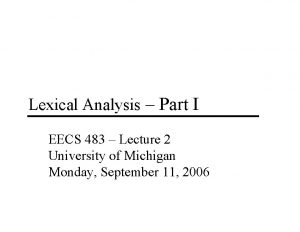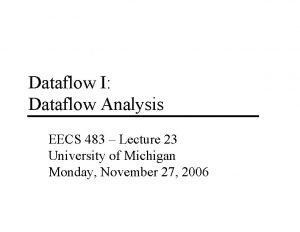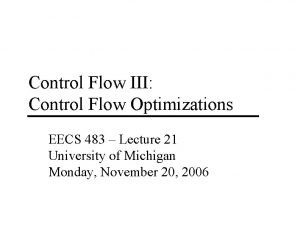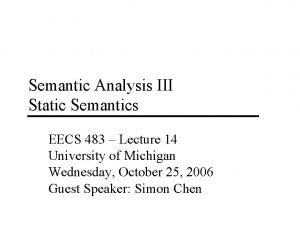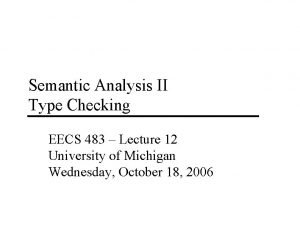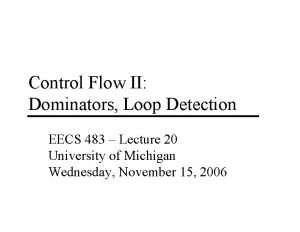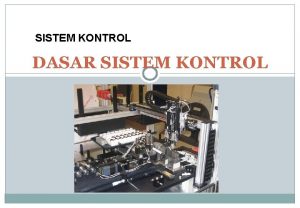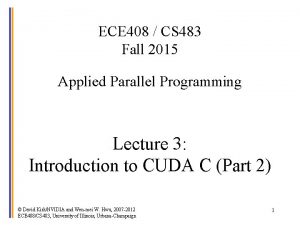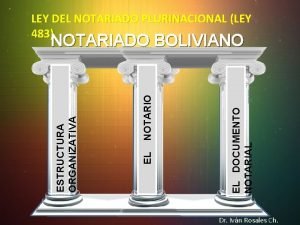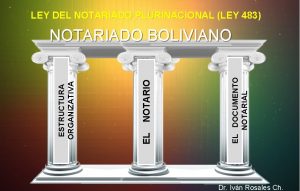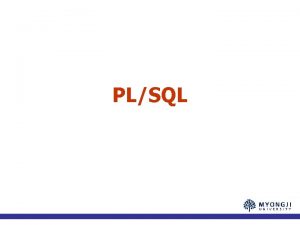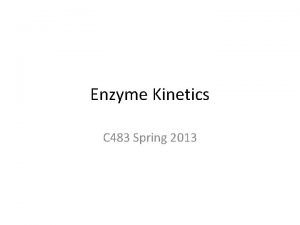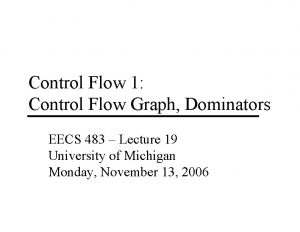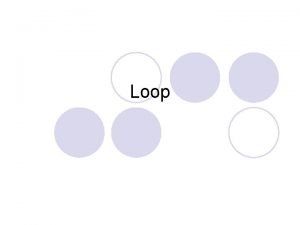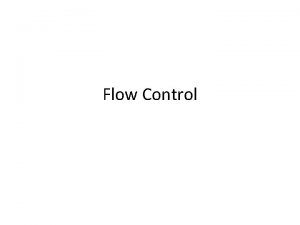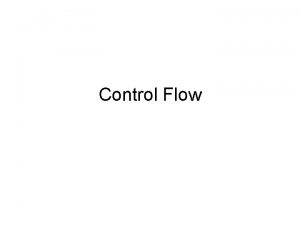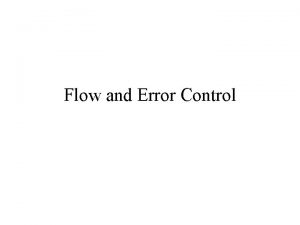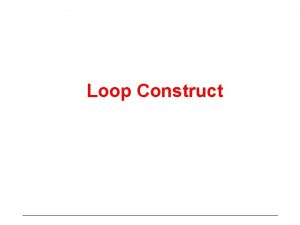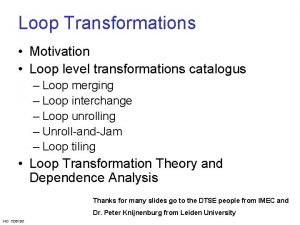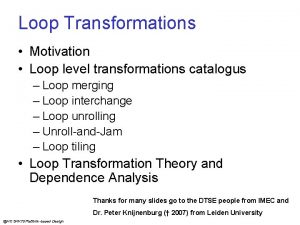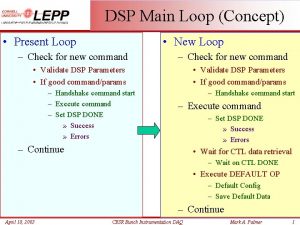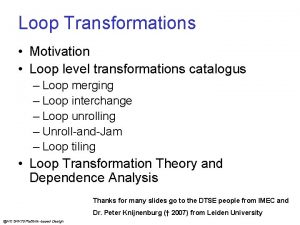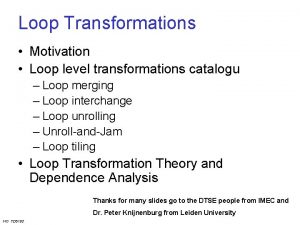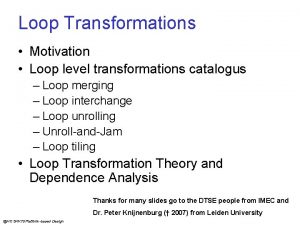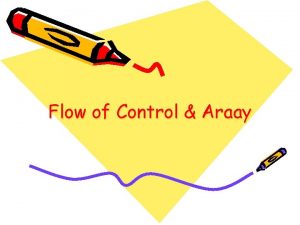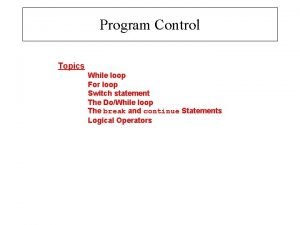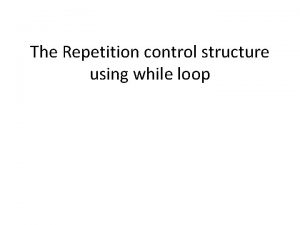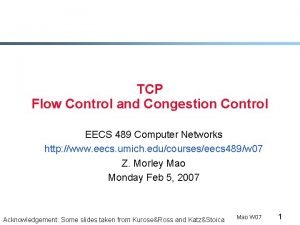Control Flow II Dominators Loop Detection EECS 483




























- Slides: 28

Control Flow II: Dominators, Loop Detection EECS 483 – Lecture 20 University of Michigan Wednesday, November 15, 2006

Announcements and Reading v Simon’s office hours on Thurs (11/16) » Moved to 10 am-12 pm, 4817 CSE » Exam 1 problem 11 was incorrectly graded Ÿ Follow set for B should contain z » See Simon to get your points back v Project 3/4 – postponed until Monday » Group formation for Project 3/4 v Today’s class material: » 10. 4, end of 10. 9 (dominator algorithm) -1 -

From Last Time: Control Flow Graph (CFG) v Defn Control Flow Graph – Directed graph, G = (V, E) where each vertex V is a basic block and there is an edge E, v 1 (BB 1) v 2 (BB 2) if BB 2 can immediately follow BB 1 in some execution sequence » A BB has an edge to all blocks it can branch to » Standard representation used by many compilers » Often have 2 pseudo vertices Ÿ entry node Ÿ exit node Entry BB 1 BB 2 BB 3 BB 4 BB 5 BB 6 BB 7 Exit -2 -

Control Flow Analysis v Determining properties of the program branch structure » Static properties Not executing the code » Properties that exist regardless of the run-time branch directions » Use CFG » Optimize efficiency of control flow structure v Determine instruction execution properties » Global optimization of computation operations » Discuss this later -3 -

Dominator v v Defn: Dominator – Given a CFG(V, E, Entry, Exit), a node x dominates a node y, if every path from the Entry block to y contains x 3 properties of dominators » Each BB dominates itself » If x dominates y, and y dominates z, then x dominates z » If x dominates z and y dominates z, then either x dominates y or y dominates x v Intuition » Given some BB, which blocks are guaranteed to have executed prior to executing the BB -4 -

Dominator Examples Entry BB 2 BB 1 BB 3 BB 4 BB 5 BB 6 BB 7 BB 6 Exit -5 -

Dominator Analysis v v Compute dom(BBi) = set of BBs that dominate BBi Initialization » Dom(entry) = entry » Dom(everything else) = all nodes v Entry BB 1 BB 2 BB 3 Iterative computation BB 4 » while change, do Ÿ change = false Ÿ for each BB (except the entry BB) u u tmp(BB) = BB + {intersect of Dom of all predecessor BB’s} if (tmp(BB) != dom(BB)) â dom(BB) = tmp(BB) â change = true BB 5 BB 6 BB 7 Exit -6 -

Immediate Dominator v Defn: Immediate dominator (idom)– Each node n has a unique immediate dominator m that is the last dominator of n on any path from the initial node to n » Closest node that dominates Entry BB 1 BB 2 BB 3 BB 4 BB 5 BB 6 BB 7 Exit -7 -

Class Problem Entry BB 1 Calculate the DOM set for each BB BB 2 BB 3 BB 4 Also identify the i. DOM for each BB BB 5 BB 6 BB 7 Exit -8 -

Post Dominator Reverse of dominator v Defn: Post Dominator – Given a CFG(V, E, Entry, Exit), a node x post dominates a node y, if every path from y to the Exit contains x v Intuition v » Given some BB, which blocks are guaranteed to have executed after executing the BB -9 -

Post Dominator Examples Entry BB 2 BB 1 BB 3 BB 4 BB 5 BB 6 BB 7 BB 6 Exit - 10 -

Post Dominator Analysis v v Compute pdom(BBi) = set of BBs that post dominate BBi Initialization » Pdom(exit) = exit » Pdom(everything else) = all nodes v Entry BB 1 BB 2 BB 3 Iterative computation BB 4 » while change, do Ÿ change = false Ÿ for each BB (except the exit BB) u u tmp(BB) = BB + {intersect of pdom of all successor BB’s} if (tmp(BB) != pdom(BB)) â pdom(BB) = tmp(BB) â change = true BB 5 BB 6 BB 7 Exit - 11 -

Immediate Post Dominator v Defn: Immediate post dominator (ipdom) – Each node n has a unique immediate post dominator m that is the first post dominator of n on any path from n to the Exit » Closest node that post dominates » First breadth-first successor that post dominates a node Entry BB 1 BB 2 BB 3 BB 4 BB 5 BB 6 BB 7 Exit - 12 -

Class Problem Entry Calculate the PDOM set for each BB BB 1 BB 2 BB 3 BB 4 BB 5 BB 6 BB 7 Exit - 13 -

Why Do We Care About Dominators? v v Loop detection – next subject Dominator » Guaranteed to execute before » Redundant computation – an op can only be redundant if it is computed in a dominating BB » Most global optimizations use dominance info v Post dominator » Guaranteed to execute after » Make a guess (ie 2 pointers do not point to the same locn) » Check they really do not point to one another in the post dominating BB - 14 - Entry BB 1 BB 2 BB 3 BB 4 BB 5 BB 6 BB 7 Exit

Natural Loops v Cycle suitable for optimization » Discuss opti later v 2 properties: » Single entry point called the header Ÿ Header dominates all blocks in the loop » Must be one way to iterate the loop (ie at least 1 path back to the header from within the loop) called a backedge v Backedge detection » Edge, x y where the target (y) dominates the source (x) - 15 -

Backedge Example BE = target dominates source E 1 : No 1 2 : No 2 3 : No 2 6 : No 3 4 : No 3 5 : No 4 3 : Yes 4 5 : No 5 3 : Yes 5 6 : No 6 2 : Yes 6 X : No Entry BB 1 dom(1) = E, 1 BB 2 dom(2) = E, 1, 2 dom(3) = E, 1, 2, 3 BB 4 BB 5 BB 6 dom(4) = E, 1, 2, 3, 4 dom(5) = E, 1, 2, 3, 5 dom(6) = E, 1, 2, 6 Exit In this example, BE = edge from higher BB to lower BB, not always this easy! - 16 -

Loop Detection v v Identify all backedges using dominance info Each backedge (x y) defines a loop » Loop header is the backedge target (y) » Loop BB – basic blocks that comprise the loop Ÿ All predecessor blocks of x for which control can reach x without going through y are in the loop v Merge loops with the same header » I. e. , a loop with 2 continues » Loop. Backedge = Loop. Backedge 1 + Loop. Backedge 2 » Loop. BB = Loop. BB 1 + Loop. BB 2 v Important property » Header dominates all Loop. BB - 17 -

Loop Detection Example Loop detection: 3 steps: • Identify backedges • Compute Loop. BB • Merge loops with the same header Entry BB 1 dom(1) = E, 1 BB 2 dom(2) = E, 1, 2 dom(3) = E, 1, 2, 3 BB 3 Loop 1: defined by 6 2 Loop. BB = 2, 3, 4, 5, 6 Loop 2: defined by 4 3 Loop. BB = 3, 4 Loop 3: defined by 5 3 Loop. BB = 3, 4, 5 BB 4 BB 5 BB 6 Merge loops 2, 3 Loop. BB = 3, 4, 5 Backedges = 4 3, 5 3 Exit - 18 - dom(4) = E, 1, 2, 3, 4 dom(5) = E, 1, 2, 3, 5 dom(6) = E, 1, 2, 6

Class Problem Find the loops Entry BB 1 What are the header(s)? BB 2 BB 3 What are the backedge(s)? BB 4 BB 5 BB 6 BB 7 Exit - 19 -

Important Parts of a Loop v v v Header, Loop. BB Backedges, Backedge. BB Exitedges, Exit. BB » For each Loop. BB, examine each outgoing edge » If the edge is to a BB not in Loop. BB, then its an exit v Preheader (Preloop) » » New block before the header (falls through to header) Whenever you invoke the loop, preheader executed Whenever you iterate the loop, preheader NOT executed All edges entering header Ÿ Backedges – no change, All others - retarget to preheader v Postheader (Postloop) - analogous - 20 -

Exit. BB/Preheader Example Entry BB 1 Pre 1 BB 2 BB 3 Pre 2 BB 3 BB 4 BB 5 BB 6 Exit Note, preheader for blue loop is contained in yellow loop Exit BB Blue loop: BB 6 Yellow loop: Exit - 21 - BB 5 BB 6 Exit

Characteristics of a Loop v Nesting (generally within a procedure scope) » Inner loop – Loop with no loops contained within it » Outer loop – Loop contained within no other loops » Nesting depth Ÿ depth(outer loop) = 1 Ÿ depth = depth(parent or containing loop) + 1 v Trip count (average trip count) » How many times (on average) does the loop iterate » for (I=0; I<100; I++) trip count = 100 » Ave trip count = weight(header) / weight(preheader) - 22 -

Trip Count Calculation Example Calculate the trip counts for all the loops in the graph Blue loop: w(header) = w(BB 3) = 1240+60+700 = 2000 w(preheader) = w(BB 2) = 60 ( why not 100? ? ? ) avg trip count = 2000/60 = 33. 3 Yellow loop: w(header) = w(BB 2) = 80+20 = 100 w(preheader) = w(BB 1) = 20 avg trip count = 100/20 = 5 - 23 - Entry BB 1 20 BB 2 1240 60 BB 3 900 80 1100 BB 4 200 BB 5 60 BB 6 20 Exit 700 40

Loop Induction Variables v v Induction variables are variables such that every time they changes value, they are incremented/decremented by some constant Basic induction variable – induction variable whose only assignments within a loop are of the form j = j +/- C, where C is a constant Primary induction variable – basic induction variable that controls the loop execution (for i=0; i<100; i++), i (virtual register holding i) is the primary induction variable Derived induction variable – variable that is a linear function of a basic induction variable - 24 -

Class Problem Identify the basic, primary, and derived inductions variables in this loop. r 1 = 0 r 7 = &A Loop: r 2 = r 1 * 4 r 4 = r 7 + 3 r 7 = r 7 + 1 r 1 = load(r 2) r 3 = load(r 4) r 9 = r 1 * r 3 r 10 = r 9 >> 4 store (r 10, r 2) r 1 = r 1 + 4 blt r 1 100 Loop - 25 -

Reducible Flow Graphs v A flow graph is reducible if and only if we can partition the edges into 2 disjoint groups often called forward and back edges with the following properties » The forward edges form an acyclic graph in which every node can be reached from the Entry » The back edges consist only of edges whose destinations dominate their sources v More simply – Take a CFG, remove all the backedges (x y where y dominates x), you should have a connected, acyclic graph - 26 -

Irreducible Flow Graph Example * In C/C++, its not possible to create an irreducible flow graph without using goto’s * Cyclic graphs that are NOT natural loops cannot be optimized by the compiler L 1: x = x + 1 if (x) { L 2: y = y + 1 if (y > 10) goto L 3 } else { L 3: z = z + 1 if (z > 0) goto L 2 } bb 1 bb 2 - 27 - Non-reducible! bb 3
 Eecs 483
Eecs 483 Eecs 483
Eecs 483 Eecs483
Eecs483 Static semantic analysis
Static semantic analysis Eecs 483
Eecs 483 483 bc
483 bc Dominate
Dominate Catalyst loopdetect
Catalyst loopdetect Data flow vs control flow
Data flow vs control flow Control flow and data flow computers
Control flow and data flow computers Transaction flow graph
Transaction flow graph Stock control e flow control
Stock control e flow control Flow control and error control
Flow control and error control Contoh open loop system
Contoh open loop system Fifth gear loop the loop
Fifth gear loop the loop Open loop vs closed loop in cars
Open loop vs closed loop in cars Manakah yang lebih baik open loop atau close loop system
Manakah yang lebih baik open loop atau close loop system Statement while... wend digunakan untuk
Statement while... wend digunakan untuk Radial and ulnar loop
Radial and ulnar loop Multi loop pid controller regolatore pid multi loop
Multi loop pid controller regolatore pid multi loop Control organization for distributed deadlock detection
Control organization for distributed deadlock detection Ley de notariado
Ley de notariado Uiuc cs 483
Uiuc cs 483 Biba n 483 ddl
Biba n 483 ddl Suhu permukaan suatu benda 483 k
Suhu permukaan suatu benda 483 k Documentos extraprotocolares bolivia
Documentos extraprotocolares bolivia Ley 483
Ley 483 오라클 프로시저 cursor
오라클 프로시저 cursor Vmax equation
Vmax equation
